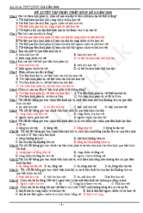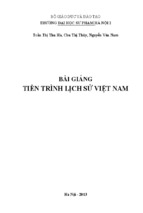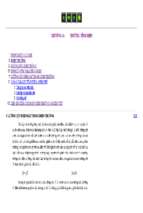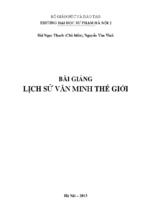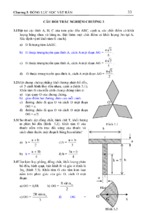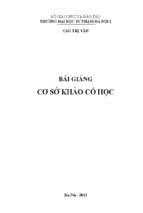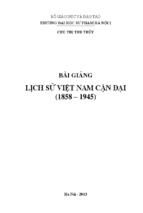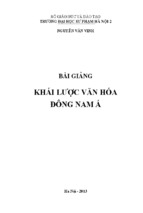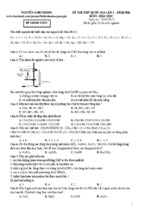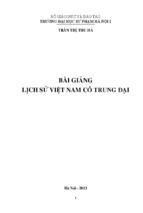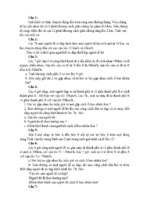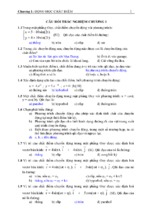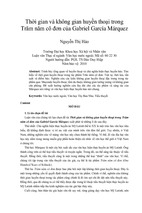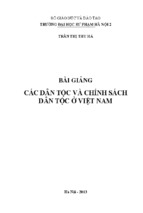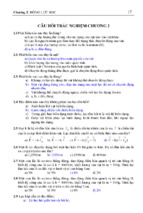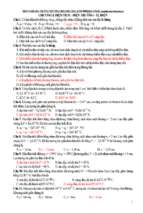107
Chapter 4
Electrostatic Fields in Matter
Problem 4.1
30
E V / x 500 /103 5 105 . Table 4.1: / 4 0 0.66 10 , so
4 (8.85 1012 )(0.66 1030 ) 7.34 10 41.
p E ed d E / e (7.34 1041 )(5 105 ) /(1.6 1019 ) = 2.29 1016 m.
d / R (2.29 1016 ) /(0.5 10 10 ) = 4.6 106. To ionize, say d = R. Then R=
E / e V / ex V R ex / = (0.5x 1010 )(1.6x10 19 )( 103 )/(7.34x10 41 ) = 108V .
Problem 4.2
1
First find the field, at radius r, using Gauss’ law: E.da Qenc , or
0
1 1
E
Qenc .
4 0 r 2
4 q r 2 r / a 2
4q a 2 r / a 2
a 2
Qenc = dr
e
r dr 3 e
r ar
0
0
a3
a 2
2
2q
a2
r
r2
2 e 2 r / a (r 2 ar ) = q 1 e 2 r / a (1 2 2 2 ) .
=
a
2
a
a
r
r
0
[Note: Qenc (r ) q. ] So the field of the electron could is
Ee
1 q
r
r2
1 e 2 r / a (1 2 2 2 ) . The proton will be shifted from r = 0 to the
4 0 r 2
a
a
point d where E e = E (the external field):
1 q
d
d 2
2 d / a
E
1 e
1 2 2 2 .
4 0 d 2
a
a
108
Expanding in powers of (d/a):
2
e
3
2
3
d
d
d2
2d 1 2 d 1 2 d
d 4d
1 ... 1 2 2 ...1 e 2 d / a 1 2 2 2
a
a
a
a 2 a 3! a
a 3a
2
3
d
d
d2
d 4d
1 1 2 2 ... 1 2 2 2
a
a
a
a 3a
d
d2
d
d2
d3
d2
d3 4 d3
2 2 2 2 4 2 4 3 2 2 4 3
...
a
a
a
a
a
a
a
3 a3
3
4d
higher order terms.
3a
2 d / a
=
=
=
E
1 q 4 d3
1 4
1
(qd )
p. 3 0 a 3 .
2
3
3
4 0 d 3 a 4 0 3a
3 0 a 3
[Not so different from the uniform sphere model of Ex.(see Eq. 4.2). Note that
1
3
3
this result predicts 4 4 a 4 (0.5 10 ) 0.09 10 m , compared with an
0
experimental value (table 4.1) of 0.66 x 10 30 m 3 . Ironically the “classical”
formula (Eq. 4.2) is slightly closer to the empirical value.]
3
10 3
30
3
Problem 4.3
r Ar . Electric field (by Gauss’s Law):
2
�.da E (4 )
E
1
1
Qenc
0
0
r
0
r r2 r
1 4 A r 4 Ar 2
Ar 4 r d r , or E=
. This “internal”
4 r 2 0 4 4 0
field balances the external field E when nucleus is “off-center” an amount d :
ad 2 4 0 E d 4 0 E A .So the induced dipole moment is p ed 2e 0 A E
.Evidently p is proportional to E1 2 .
For Eq. 4.1 to hold in the weak – field limit , E must be proportional to r , for
small r , which mean that must go to a constant (not zero) at the origin : (0) 0
(nor infinite)
109
Problem 4.4
1
q
q
ˆ
ˆ
Field of q : 4 r 2 r . Induced dipole moment of atom : p E 4 r 2 r .
0
0
Field of this dipole , at location of q ( , in Eq.3.103 ) : E
1 1 2 q
4 0 r 3 4 0 r 2
( to the right ) .
Force on q due to this field : ( attractive ) .
Problem 4.5
p
1
Field of p1 at p2 ( 2 in Eq. 3.103 ) : E1 4 r 3 ˆ ( points down ).
0
pp
o
1 2
Torque on p2 : N 2 p2 E1 p2 E1 sin 90 p2 E1 4 r 3 ( points into the page).
0
2p p
1 2
Torque on p1 : N1 p1 E2 4 r 3 (points into the page )
0
Problem 4.6
Use image dipole as shown in Fig .(a). Redraw , placing pi at the origin , Fig.
(b).
Ei
p
4 0 2 z
3
2 cos rˆ sin ˆ ;
ˆ
ˆ
p p cos r p sin .
( out of the page ).
But sin cos 1 2 sin 2 , so N
p 2 sin 2
(out of thae page )
4 0 16 z 3
For 0 2, N tends to rotate p counterclockwise ; for 2 , N rotates p
clockwise . Thus
the stable orientation is perpendicular to the surface –either or .
110
Problem 4.7
Say the field is uniform and points in the y direction . First slide p in from
infinity along the x axis-this takes no work , since F is dl. (If E is not
uniform , slide p in along a trajectory the field.) Now rotate (counterclockwise
ˆ
) into final position . The torque exerted by E is N p E pE sin z. The torque
we exert is N pE sin clockwise , and d is counterclockwise , so the net work
done by us is negative :
U
pE sin d
2
pE cos
2
pE cos cos pE cos p.E.
2
qed
Problem 4.8
U p1.E2 , but E2
1 1
1 1
ˆ ˆ
ˆ
ˆ
3( p2 .r )r p2 . So U
p1 p2 3 p1r p2 .r .
3
4 0 r
4 0 r 3
Problem 4.9
a F p. E Eq.4.5 ; E
qed
ˆ
ˆ ˆ
1 q
q
xx yy zz
ˆ
r
2
4 0 r
4 0 x 2 y 2 z 2 3 2
q
x
Fz px
py
pz
x
y
z 4 0 x 2 y 2 z 2 3 2
q
1
3
2x
2y
p y 3 x
pz
p
x
2 x2 y 2 z 2 5 2
4 0 x 2 y 2 z 2 3 2 2 x 2 y 2 z 2 5 2
q pz 3 x
q
5 px x p y y pz z
3
4 0 r
r
4 0
p 3r p.r
3
.
r
r5
x
111
F
1 q
ˆ ˆ
p 3 p.r r .
4 0 r 3
b
E
1 1
1 1
ˆ ˆ
ˆ ˆ
3 p. r r p
3 p.r r p . (This is from
3
4 0 r
4 0 r 3
Eq. 3.104; the minus signs are beause r points toward p , in this
problem .)
F qE
1 q
ˆ
3 p.r p .
4 0 r 3
[Note that the forces are equal and opposite , as you would expect from
Newton’s third law .]
Problem 4.10
ˆ
(a) b P.n kR; b .P
1 2
r kr r12 3kr 2 3k.
3
r r
1
ˆ
(b) For r < R , E= 3 rr (Prob. 2.12 ) , so E k 0 r.
0
For r > R, same as if all charge at center ; but
4
Qtot kR 4 R 2 3k R 3 0 , so E 0.
3
Problem 4.11
ˆ
b 0; P.n P (plus sign at one end-the one P points toward ; minus
sign at the other-the one P points away from ).
112
(i)
L >> a. Then the ends look like point charges , and the whole
thing is like a physical dipole , of length L and charge P a 2 .
See Fig. (a).
(ii)
L<< a. Then it’s like a circular parallel-plate capacitor.Field is
nearly uniform inside ; nonuniform “fringing field” at the
edges . See fig . (b).
(iii)
L a. See fig .(c).
Problem 4.12
V
1
4 0
ˆ
P.r
r
2
1
ˆ
r
dr P.
r 2 dr . But the term in curly brackets is precisely the
4 0
field of a uniformly charged sphere , divided by p. The integral was done
esplicitly in Prob .2.7 and 2.8 :
1 4 3 R 3 p
ˆ,
r
r2
ˆ
1
r
1 4 0
dr
4 0 r 2
p 1 4 3 R 3 p
ˆ,
r
4
R3
0
r R
R3
R 3 P cos
ˆ
P.r
,
r R ,
2
3 0 r 2
3 0 r
So V r ,
Pr cos
1
r R ,
,
3 P.r 3
0
0
r R
Problem 4.13
Think of it as two cylinders of opposite uniform charge density . Inside the
field
113
At a distance s from the axis of a uniformly charge cylinder is given by Gauss’s
1
2
law : E 2 sl s l E 2 0 s. For two such cylinders , one plus and one
0
minus. The net field (inside) is E E E 2 0 s s . But s s d , so
E d 2 0 , where d is the
Vector from the negative axis to positive axis . In this case the total dipole
2
2
moment of a chunk of length l is P a l a l d . So d P, and
E P 2 0 , for s < a .
Outside , Gauss s law give E 2 sl
’
ˆ
1
a2 s
a 2l E
, For one cylinder . For
0
2 0 s
ˆ
ˆ
a 2 s s
the combination , E E E
, where
2 0 s s
d
s s m ;
2
1
1
s d 2 d 2
1
d s.d
1 d s.d
s m s
m .d 2 s m 1 m 2 2 s m 1 2
s
2
s
2
4
s
2
s
s
2
s
s.d d
1
s s 2 m
2
s
s
2
( keeping only 1st order terms in d )
s s 1
ˆ
ˆ
s.d d
s 1 s s.d
s .d
d .
2 s s 2 s s s 2 2 2
2
s
2
2 s
s
s s s
E s
a2 1
ˆ ˆ
2 P.s s P , for s > a
2 0 s 2
Problem 4.14
114
Total charge on the dielectric is Qtot � b da b d � .da .Pd . But the
s
s P
divergence theorem says
� .da .Pd ,
P
s
so Qenc 0. qed
Problem 4.15
1 2k
k
r 2 ;
2
r r r
r
ˆ
P.r k b
r b,
ˆ
b P.n
ˆ
P.r k a
r a.
(a) b .P
1 Q
enc
ˆ
Gauss’s law E 4 r 2 r. For r < a , Qenc = 0 , so E 0 . For r > b , Qenc =0
0
(Prob. 4.14) , so E 0
r k
k
2
2
4 a 2 4 r dr 4 ka 4 k r a 4 kr ; so
a
a
r
For a < r< b , Qenc
ˆ
E k 0 r r.
(b)
�.da Q
D
f enc
0 D 0 everywhere . D 0 E P 0 E 1 0 P, so
E 0 (for r < a and r > b );
ˆ
E k 0 r r (for a < r < b)
Problem 4.16
(a) Same as E0 minus the field at the center of sphere with uniform
1
polarization P. The latter (Eq. 4.14) is P 3 0 . So E E0 3 P
0
1
1
2
D 0 E 0 E0 P D0 p p, So D D0 P.
3
3
3
115
(b) Same as E0 minus the field of charges at the two ends of the “needle” –
but these are small , and far away , so E=E0
D 0 E 0 E0 D0 P, so D D0 P.
(c) Same as E0 minus the field of a parallel-plate capacitor with upper plate at
P . The later is E E0
1
P 1 0 P, s D 0 E 0 E0 P, so D D0. o
0
Problem 4.18
(a) Apply D.da Q f to the Gaussian surface shown . DA A D . (Note :
D =0 inside the metal plate .) This is true in both slabs ; D points down .
(b) D E E 1 in slab 1 , E 0 in slab 2 . But 0 r , so
enc
3
1 2 0 ; 2 0 . E1 2 0 , E2 2 3 0 .
2
1
(c) p 0 e E , so P 0 e d 0 r e r ; e r 1 P 1 r .
P 2, P2 3.
1
(d) V E1a E2 a a 6 0 3 4 7 a 6 0 .
(e) b 0; b P at bottom of slab 1 2,
1
2
2
b P2 at bottom of slab
3,
b P at top of slab 1 2,
1
b P2 at top of slab
3,
(f) In slab 1 : total surface charge above : 2 2
total surface charge below : 2 3 3 2,
In slab 2 : total surface charge above : 2 2 3 2 3,
total surface charge below : 3 2 3,
116
problem 4.19
With no dielectric , C0 A 0 d (Eq. 2.54).
In configuration (a) , with on upper plate , on lower , D between the
plates .
E 0 (in air ) and E (in dielectric). So V
Ca
Q 0 A 2
V
d 1 1 r
d d
Qd 0
1
.
0 2 2 2 0 A
Ca
2 0
.
C0 1 r
In configuration (b) , with potential difference V : E V d , so 0 E 0V d
( in air ).
P 0 eV d (in dielectric) , so b 0 eV d (at top surface of dielectric ).
tot 0V d f b f 0 eV d , so f 0V 1 e d 0 rV d (on top plate
above dielectric).
Cb
Q 1 A
A A V
V A 0 1 r
f
0 0 r
V V 2
2 2V d
d d 2
Cb 1 r
.
.
2
C0
[Which is greater ?
Cb Ca 1 r
1 r 4 r 1 2 r 4 r2 4 r 1 r 0.
2 r
So Cb > Ca ]
C0 C0
2
1 r
21 r
2 1 r
21 r
2
2
If the x axis points down :
Problem 4.20
4
1
ˆ
D4 r 2 r 3 D r E r 3 r , for
3
3
4
ˆ
r R; D 4 r 2 R 3 D R 3 3r 2 E R 3 3 0 r 2 r , for r >R .
3
D.da Q
f enc
R3 1
V E.dl
3 0 r
0
R
3
R2 R2 R2
1
R rdr 3 0 3 2 3 0 1 2 r .
0
117
Problem 4.21
Let Q be the charge on a length l of the inner conductor .
�.da D2 sl Q
D
D
Q
Q
a s b , E Q ( b< r< c ).
; E
2 0 sl
2 sl
2 sl
a
b Q
c Q ds
ds
Q b 0 c
V E.dl
ln ln .
c
a 2 l
b 2 l
s 2 0l a b
0 s
2 0
C Q
.
l Vl ln b a 1 r ln c b
Problem 4.22
Same method as Ex. 4.7 : Solve Laplace’s equation for Vin s, ( s < a ) and
Vout s, (s > a ), subject the boundary condition .
(i) Vin Vout
at s = a ,
Vout
s
(iii) Vout E 0 s cos
(ii)
at s = a ,
for s >> a .
From Prob. 3.23 (invoking boundary condition (iii)):
Vin s, s k ak cos k bk sin k
k 1
.
( I eliminated the constant terms by seting V = 0 on the y z plane .) Condition (i)
says
a k ak cos k bk sin k E0 s cos a k ck cos k d k sin k ,
While (ii) says
r ka k 1 ak cos k bk sin k E0 cos ka k 1 ck cos k d k sin k .
Evidently bk d k 0 for all k , ak ck 0 unless k = 1 , whereas for k = 1 ,
aa1 E0 a a 1c1 , r a1 E0 a 2c1 .
Solving for a1 ,
a1
E0
E0
E0
, so Vin s,
s cos
x,
1 e 2
1 e 2
1 e 2
118
V
E
in
0
ˆ
and hence Ein s, x x 1 2 . As in the spherical case ( Ex. 4.7 ) , the
e
field inside is uniform .
Problem 4.23
P0 0 e E0 ; E1
2
1
1
p0 e E0 ; P 0 e E1 0 e E0 ; E2
P e E0 ; …
1
1
3 0
3
3
3 0
9
n
Evidently En e E0 , so
3
e n
E E0 E1 E2 ... E0 .
n0 3
The geometric series can be summed explicitly :
n 0
xn
1
1
E
, so E
1 e 3 0 ,
1 x
Which agrees with Eq. 4.49. [Curiously , this method formally requires that
e 3 (else the infinite series diverges ) , yet the result is subject to no such
restriction , since we can also get it by the method of Ex. 4.7.]
Problem 4.24
Potentials :
Bl
Vout r , E0 r cos r l 1 Pl cos ,
t Bl
( a < r 0 )
1
q
q r' r
2q
Meanwhile , since ' qt ' 1 '
, V r 4
'
r
r r r r r
0
2q r' r
x2 y 2 z d
(for z < 0 ).
Problem 4.26
From Ex. 4.5:
0, r a
0, r a
Q
ˆ
D Q
r, a r b
, E
2
ˆ
r, r a
4 r
4 r 2
Q
ˆ
4 r 2 r , r b
0
W
1 b 1 1 2
1
1 Q
1
D.Edr 2 4 2 4 a r 2 r 2 r dr 0
2
Q2
8 0
b
1 Q2
dr
r2
8
1 1 b 1 1
r a 0 r b
1 1 1 1
Q2
1 e
.
1 e a b b 8 0 1 e a b
Problem 4.27
Using Eq. 4.55 : W
0
E 2 dr . From Ex. 4.2 and Eq. 3.103 ,
2
2
122
1
ˆ,
3 Pz
0
E 3
R P 2cos r sin ˆ ,
ˆ
3 0 r 3
r R
, so
r R
2
Wr R
P 4 3 2 P 2 R 3
0
.
R
2 3 0 3
27 0
Wtot
2 R 3 P 2
9 0
This is the crrect electricstic energy of the configuration , but it is not the “ total
work necessary to assemble the system ,” because it leaves out the mechanical
energy involved in polarizing the molecules .
1
1
D.Edr. For r R, D 0 E D 3 P P 2 0 E , so
2
2 P 2 R 3
4 R 3 P 2
1
D.E 2 0 E 2 , and this contribution is now 2
, exactly
27 0
2
2
27 0
Using Eq. 4.58 : W
canceling the exterior term . Conclusion : Wtot 0 . This is not surprising , since
the derivation in Sect. 4.4.3 calculates the work done on the free charge , and in
this problem there is no free charge in sight . Since this is a nonlinear dielectric ,
however , the result cannot be interpreted as the “ work necessary to assemble
the configuration’’ – the latter would depend entirely on how you assemble it .
Problem 4.28
First find the capacitance , as a function of h :
123
2
2
E
V
ln b a
4 0 s
4 0
' '
; r .
Air part :
0
0
2 '
2 '
2 '
D
E
V
ln b a ,
4 s
4 s
4
Oil part :
Q ' h l h r h h l r 1 h l e h l , where l is the total
height .
C
h l
Q eh l
4 0 2 0 e
V 2 ln b a
ln b a
1
dC
1
2
2
2
0 e
The net upward force is given by Eq. 4.64 : F 2 V dh 2 V ln b a
2
2
The gravitational force down is F mg b a gh
Problem 4.29
(a) Eq. 4.5 F2 p2 E1 p2 y E1 ;
p
p
1
1
ˆ
Eq. 3.103 E1 4 r 3 ˆ 4 y 3 z . Therefore
0
E2
0
3 p1 p2
p1 p2 d 1
3 p1 p2
ˆ
F2
z ( upward )
ˆ
3 z
4 or
4 0 r 4
4 0 dy y
4 0 y
ˆ
To calculate F1 , put p2 at the origin , poiting in the z direction ; then p1 is at rz ,
ˆ
and it points in the y direction . So F1 p1 E2 p1
need E2 as a function of x , y , and z .
From Eq. 3.104 : E2
and hence p2 .r p2 y
E2
y
; we
x y 0, z r
1 1 3 p2 .r r
ˆ
ˆ ˆ
ˆ
p , where r xx yy zz , p2 p2 y ,
3
2
4 0 r r
124
2
2
2
2
2
2
ˆ
ˆ ˆ
ˆ
ˆ
ˆ
ˆ
p2 3 y xx yy zz x y z y
p2 3xyx x 2 y z y 3 yzz
E2
52
52
4 0
4 0
x2 y 2 z 2
x2 y 2 z 2
E2
p 5 1
1
ˆ
ˆ
ˆ
ˆ
ˆ
ˆ
2 7 2 y 3 xyx x 2 2 y 2 z 2 y 3 yzz 5 3xx 4 yy 3zz
y 4 0 2 r
r
E2
y
0, 0
p 3r
p2 3 z
3p p
ˆ;
ˆ
ˆ.
z F1 p1 2 5 z 1 24 z
5
4 0 r
4 0 r
4 0 r
There results are consistent with Newton’s third law : F1=-F2 .
(c) From page 165 , N 2 p2 E1 r F2 . The first term was calculated in
ˆ
Prob . 4.5 ; the second we get from (a) , using r ry :
p2 E1
p1 p2
3p p
ˆ
x ; r F2 ry 1 24
ˆ
3
4 0 r
4 0 r
2 p1 p2
3 p1 p2
ˆ
x
ˆ
ˆ
z
x ; so N 2
3
4 0 r 3
4 0 r
This is equal and opposite to the torque on p1 due to p2 , with respect to the
center of p1 ( see Prob. 4.5 ) .
Problem 4.30
Net force is to the right ( see diagram ) . Note that the field lines must bulge to
the right , as shown , beause E is perpendicular to the surface of each conductor .
Problem 4.31
ˆ
ˆ ˆ
P kr k xx yy zz b .P k 1 1 1 3k .
Total volume bound charge : Qvol 3ka 3
ˆ
ˆ ˆ,
b P.n . At top surface , n z z a 2 ; so b ka 2 . Clearly , b ka 2 on all
six surface .
2
3
Total surface bound charge : Qsorf 6 ka 2 a 3ka . Total bound charge is
zero .
125
Problem 4.32
�.da Q
D
f enc
b .P
D
ˆ
ˆ
qe
q
1
q
r
r
ˆ
r; E D
; P 0 e E
.
2
2
2
4 r
4 0 1 e r r
4 1 e r 2
qe
4 1 e
Qsurf b 4 R 2 q
ˆ
e 3
q e
r
ˆ
r ; Eq.1.99 ; b P.r
. 2 q1
1 e
4 1 e R 2
r
e
. The compensating negative charge is at the center :
1 e
q
q
dr 1 r dr 1
3
e
e
.
b
e
e
Problem 4.33
E is continuous ( Eq. 4.29 ) ; D is continuous ( Eq. 4.26 , with f 0 ) . So
Ex Ex ; Dy Dy 1 E y 2 E y , and hence
1
2
1
2
1
2
tan 2
2 . qed
tan 1 Ex1 E y1 E y2 1
Ex2 E y2
E y1
tan 2
2
If 1 is air 2 is dielectric , tan 1 , and the field lines bend away from the
1
1
normal . This is the opposite of light rays , so a convex “lens” would defocus the
field lines .
Problem 4.34
In view of Eq. 4.39 , the net dipole moment at the center is
p' p
1
1
1
p
p p .We want the potential produced by p’ ( at the
1 e
1 e
r
center ) and b ( at R ). Use separation of variables :
B
Eq.3.72
Outside : V r , l l1 Pl cos
l 0 r
1 p cos
Inside : V r ,
Al r l Pl cos Eqs.3.66,3.102
4 0 r r 2
l 0
Bl
l
l 1 Al R
R
R
V continuous at R
B
1
p
1
A1 B,
2
4 0 r R 2
R
126
or
.
p
B1
A1 R 3
4 0 r
Bl R 2l 1 Al
Bl
V
V
1 2 p cos
1
l 1 l 2 Pl cos
lAl R l 1 Pl cos b
3
r R r R
R
4 0 r R
0
1
1
V
1 2 p cos
ˆ
ˆ
P.r 0 e Er e
e
lAl R l 1Pl cos .
3
0
0
r R
4 0 r R
l 1
Bl
lAl R l 1 elAl R l 1 l #1 ; or 2l 1 Al R l 1 elAl R l 1 Al 0 l #1 .
l 2
R
For l = 1
2
B1
1 2p
1 2p
p
A R3
1 e p
A R3
Al e
A1 B1
1
e 1
3
R 3 4 0 r R3
4 0 r
2
4 0 r
2
4 0 r R
p
p
A1 R 3
1 e p
A1 R 3
A1 R 3
1 e p
3
A1 R
e
3 e
4 0 r
4 0 r
2
4 0 r
2
2
4 0 r
A1
2e p
1
1 2 r 1 p
p
; B1
3
3
4 0 R r 3 e 4 0 R r r 2
4 0 r
q cos 3
V r,
r R .
2
4 0 r r 2
2 r 1
p
3 r
.
1
r 2 4 0 r r 2
- Xem thêm -

